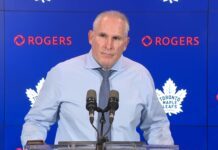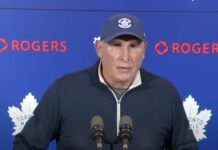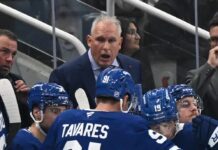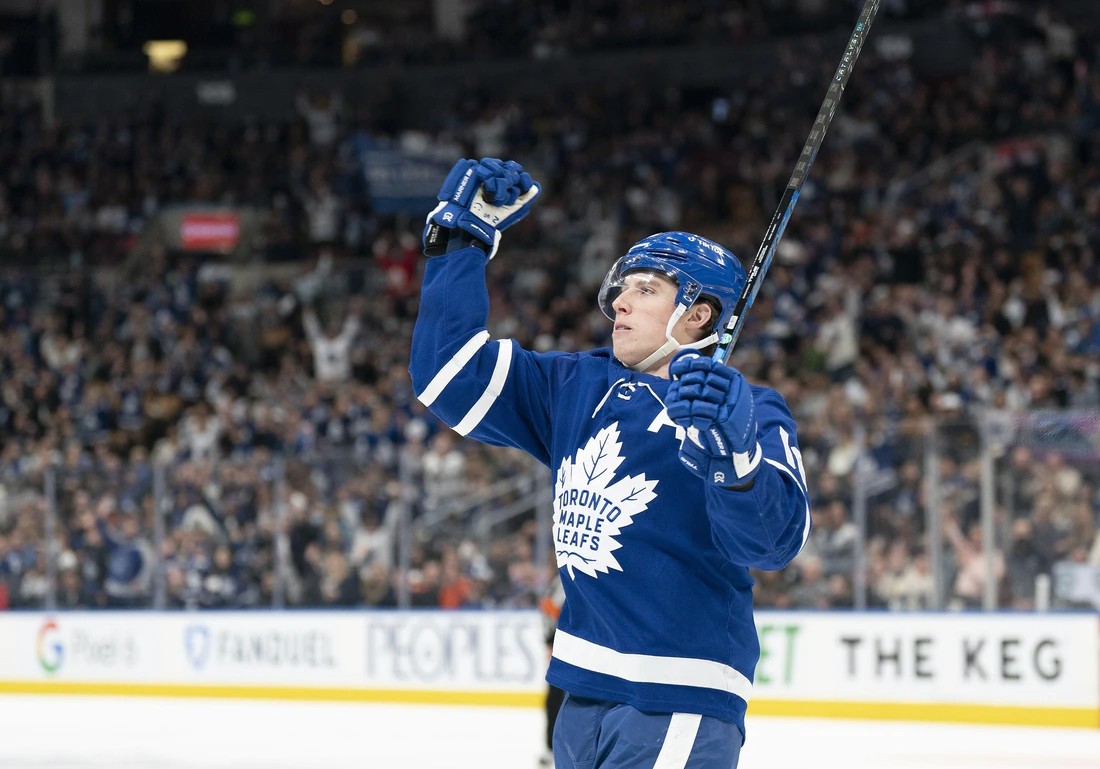As we inch closer to the draft and free agency, we’ve spent a lot of time poring over the Maple Leafs roster as it stands today and identifying the areas they need to address this offseason. A clear list of needs has emerged:
- A legitimate top-nine center
- Two real top-four defensemen
- A quality left winger (this does not need to be a top-line player by any means)
- A good goalie option in net to tandem with Joseph Woll and likely a (veteran) third stringer behind those two as injury insurance
It is a long list, and centers and right-handed defensemen are arguably the two most difficult assets to acquire in the league today.
Earlier this offseason, I wrote that the next step this offseason for the Leafs is to set a course with Mitch Marner one way or another. Without clarity on the Marner file, it will be hard to a) figure out the cap situation and b) understand the team’s needs. Put another way, maybe they only need one defenseman from the UFA market if they move Marner for an impact blue liner.
These are very hard trades to make, as Brad Treliving has already experienced with Matthew Tkachuk in Calgary. On the flip side, he has also done quite well in a similar-ish situation when he traded Dougie Hamilton for Noah Hanifin and Elias Lindholm. It’s not impossible to fetch a great return for a great player, change the roster dynamic in the process, and breathe some fresh air into a group carrying a lot of baggage.
Last summer, when Brad Treliving talked about William Nylander’s pending unrestricted free agency, he sang a very different tune than he has with Marner:
“You work the process. If there is nothing out there to make the team better, it doesn’t make sense to make a trade just to stand up there and say, “Hurrah, I made a trade.”
Our focus, when you talk about Willy, is strictly to get him signed. You are always talking to people. That is the job. The job of the manager is to know, A) What is going on in the league, and B) Are there avenues to make your team better regardless of who it is?
The priority is to sign the player and to always have your ears open for whether there are opportunities to make the team better.”
Management was clear the entire time that they wanted to keep Nylander, and they eventually locked him up to the maximum term. Marner has not received anything remotely resembling this kind of endorsement. Even in Treliving’s most recent pre-draft availability, he made it clear that Marner is a star, but at no point did he vocally support retaining and/or extending him as he did with Nylander.
That’s not to say the situation won’t change or that Marner is certainly leaving. Still, we would be foolish not to dig deeper into a trade beyond the refrain, “Be careful.” (Opposing GMs are likely not offering the Leafs great returns, and the team’s overall needs are the true priorities).
Beyond anything personnel or cap-related, it’s also possible that both camps conclude that Marner playing out his time in Toronto on an expiring contract is an undesirable scenario for everyone involved, and as a result, a trade would be best for all parties.
The more I’ve looked at the Leafs’ needs this offseason, the more difficult it is to see them genuinely addressing all of them within their current cap and roster construction. Are they really going to be able to add two top-four defensemen, a quality center, a solid goalie, and fill out their roster with just $20 million? They don’t have a collection of picks or prospects to throw around in trades, either. The most feasible avenue is a Marner trade that resets the cap structure and focuses on improving the defense and/or center position.
Alas, there are several ways the Leafs could arrive at the decision to trade Marner. The natural follow-up question: What should the deal look like if they move him?
Historical comparables and a possible Marner trade framework
It’s difficult to find examples of teams trading away star talent of this calibre. Marner is a perennial top-10 scorer, and those players, at age 27, simply do not get moved.
You’ll never find an exact comparable, but plenty of stars have been traded. I wanted to pull a few examples to demonstrate the types of packages teams have fetched in return. From there, we can identify the framework that makes sense for the Leafs.
- Ilya Kovalchuk was traded from the Atlanta Thrashers, along with Anssi Salmela and a second-round pick in the 2010 draft (Jon Merrill), to the New Jersey Devils in exchange for Johnny Oduya, Nicklas Bergfors, Patrice Cormier, a first-round pick in the 2010 draft (Kevin Hayes), and a second-round pick in the 2010 draft (Justin Holl).
- Jack Eichel was traded from the Buffalo Sabres, along with a conditional third-round pick in the 2023 draft (Mathieu Cataford), to the Vegas Golden Knights in exchange for Peyton Krebs, Alex Tuch, a conditional first-round pick in the 2022 draft (Noah Ostlund), and a conditional second-round pick in the 2023 draft (Riley Heidt).
- Ryan O’Reilly was traded from the Buffalo Sabres to the St. Louis Blues in exchange for Tage Thompson, Patrik Berglund, Vladimir Sobotka, a first-round pick in the 2019 draft (Ryan Johnson), and a second-round pick in the 2021 draft (Benjamin Roger).
- Rick Nash was traded from the Columbus Blue Jackets, along with Steven Delisle and a third-round pick in the 2013 draft (Pavel Buchnevich), to the New York Rangers in exchange for Brandon Dubinsky, Artem Anisimov, Tim Erixon, future considerations, and a first-round pick in the 2013 draft (Kerby Rychel).
- Mike Richards was traded from the Philadelphia Flyers, along with Rob Bordson, to the Los Angeles Kings in exchange for Wayne Simmonds, Brayden Schenn, and a second-round pick in the 2012 draft (Devin Shore).
- PK Subban was traded from the Montreal Canadiens to the Nashville Predators in exchange for Shea Weber.
- Brendan Shanahan was traded from the St. Louis Blues to the Hartford Whalers in exchange for Chris Pronger.
- Brendan Shanahan was traded from the Hartford Whalers, along with Brian Glynn, to the Detroit Red Wings in exchange for Keith Primeau, Paul Coffey, and a first-round pick in the 1997 draft (Nikos Tselios).
We can look through all sorts of past trades, but the general theme when I scour the above list is simple: less is more. First-round picks and shiny prospects always seem to catch the eye, but in most cases, it’s really a group attractiveness effect; it looks like a lot, but it turns into little. That’s how the Thrashers ended up trading Ilya Kovalchuk, an elite goal-scoring winger who drove the Devils to the Cup final, for basically Johnny Oduya and Kevin Hayes, a trade they never would have made in hindsight in terms of the value exchanged.
Instead, the best trades are the ones where a limited number of high-end pieces are swapped. The Canadiens grew tired of PK Subban (sound familiar?) and traded him for one player, who ended up captaining them to the Cup final and was just inducted into the Hall of Fame. The Predators also went to the Cup with PK Subban on the team. Brendan Shanahan was traded straight up for another Hall of Famer (Chris Pronger) and again for another HOFer in his down years (Paul Coffey) along with a young Keith Primeau, who went on to an excellent career in his own right.
However, given his salary and upcoming contract negotiation, I don’t think we’ll see anyone who finished even inside the top 30 of league scoring this past season traded straight up for Marner this summer.
The Mike Richards trade also stands out. It’s not a one-for-one swap, but it’s a star in his prime moving for two young pieces who became All-Stars in their own right. If the team isn’t receiving one elite player back in return, two quality high-end players (or ones with high-end upside) can make sense – especially if they are centers and/or defensemen, the Leafs’ two biggest needs.
The idea of trading for two quality assets, including a higher-end player who is worse than Marner overall but at least keeps the team competitive, could be appealing. Whoever the player is, he’s almost certainly not going to carry the pedigree of Marner, so the gap between the two players will need to be filled after the first player is identified.
Hypothetical Trade Negotiation: St. Louis’ Pavel Buchnevich +
Let’s take Pavel Buchnevich as an example. We know the following: He’s available, played for Craig Berube, and has even taken to the center position. He makes sense as either a top-line winger for Matthews or a second-line center, which gives the Leafs a center group of Matthews-Buchnevich-Tavares-Kampf. While they’re all lefties, it is an incredibly deep group.
Marner is two years younger than Buchnevich and has 238 more career points than him. For all of Marner’s noted playoff struggles, Buchnevich has played in just 20 playoff games so far in his career and has one goal and 12 points. The gap is significant. How could St. Louis close it by adding more to the trade?
It would have to start with one of their best prospects, and at that point, it’s about how the Leafs brass values them. Would a prospect like Jimmy Snuggerud, who played with Matthew Knies in college, make sense? We’re now looking at a high-end player and a good prospect as a package, which still might not be enough for a top-10 scorer talent.
Buchnevich would ease the transition of losing Marner; they would clear the cap space to add more scoring (while addressing the center position, in theory, with Buchnevich) and a good prospect to their pipeline. However, they’d likely have to add a draft pick on top of the other pieces to close the value gap. From St. Louis’ end, they’d be trading all of those assets in order to pay Marner huge money, and they already invested $8.125 million into a right winger long-term in Jordan Kyrou.
Hypothetical Trade Negotiation: Vegas’ Shea Theodore +
Vegas’ Shea Theodore has also been mentioned in the rumour mill. He is a quality top-four defenseman with actual playoff pedigree, but he is also two years older than Marner and not one of the best at his position (which Marner is). Again, there is a gap to bridge, but Vegas likely represents the most straightforward path to a trade that makes the Leafs a highly competitive team.
Adding a first-round pick to Theodore is not enough; the Leafs should target one of the Vegas centers in this scenario, be it William Karlsson (who just produced a 30-goal season) or Nicolas Roy, who is as solid of a 3C as there is in the league.
While both are older than Marner, the Karlsson-and-Theodore framework is again similar to Hamilton for Lindholm and Hanifin. If it were Roy instead of Karlsson, Vegas would have to add a first-round draft pick; a top-four defenseman and third-line center for a top-10 scorer simply doesn’t cut it. For that matter, you can argue it wouldn’t meet the desired asking price with Karlsson in the deal over Roy, either, but these are two premium positions, and all three players are signed to good-value contracts (which is a factor, even if Theodore only has a year left on his deal).
Is Vegas ready to shed two players who played a huge role in their Cup win and have more good years ahead of them? Would they wave goodbye to Jonathan Marchessault, too, as part of this deal, or pay him and Marner? They are a ruthless organization, but that would be an interesting choice.
Hypothetical Trade Negotiation: Carolina’s Martin Necas +
Another example is Carolina’s Martin Necas, who is two years younger than Marner but has also produced significantly less (53 points last season). There is a chance Marner hits Necas’ 2024-25 season points total by Christmas, but Necas is younger and bigger and is said to be eyeing a move back to center. A Marner trade isn’t worth it if you’re going to add a notably worse winger. It has to upgrade them down the middle or on defense. Winger is the easiest position to backfill; good ones hit the market every summer.
Even if we considered Necas a center, the gap between him and Marner is a very big one to close. The Hurricanes, to me, would have to include a high-end prospect like Scott Morrow, who is a 6’2 right-handed defenseman ready for NHL action. The Leafs would be a worse team the day the trade is made, but if Necas can settle in at center and Morrow emerges as a good top-four defenseman, it again resembles the Hamilton-for-Hanifin-and-Lindholm deal.
Unlike the Vegas scenario, the Leafs would be betting on the upside rather than proven production. It’s a potential upper-tier center/winger and defenseman in exchange for a high-tier player. Add to it the cap space the Leafs gain to round out the defense properly and backfill some of the scoring deficit, and they would be trending in the right direction.
Similar to the St. Louis question, though, is Carolina going to part with one of their better young prospects in Morrow and their best trade chip to target a right winger, knowing they already have Seth Jarvis? They may think Marner is too good to pass up the opportunity. Or maybe a small-market owner has no interest in paying Marner around $100 million and instantly making him Carolina’s highest-paid player (paid millions more than their 1C, Sebastian Aho).
That’s partly why this is such a hard trade to make for Treliving. Teams are not only acquiring a great player but one who comes with baggage, including a dodgy playoff history, a big salary, and an even bigger contract demand just around the corner. The Athletic Vancouver wrote the following about Marner as a trade target:
“It’s now somewhat widely understood that Marner is overpaid by a couple of million per season on his second contract, but on a one-year deal, that likely helps keep the acquisition cost somewhat reasonable for a bona fide top-of-the-lineup price in a potential trade.”
We hear the price tag on Necas and Buchnevich described as through the roof, and those are two notably less accomplished players than Marner. Yet Marner’s acquisition cost should be “somewhat reasonable?”
We aren’t even talking about winning the trade unless you believe it’s a straight-up addition by subtraction with Marner (I don’t personally). We are just talking about fetching good value while looking to address bigger needs at center/defense and taking a step back on the wing, where Matthews can hopefully make up for it by driving (much) lesser wingers to success. The reality is that Marner’s salary and impending contract demands are likely to drive his price down more than anything.
The alternative trade package of a high draft pick + +
There is also a case to be made for a deal that involves a high draft pick as one of the prime assets in the trade. A trade like Cory Schneider for the ninth-overall pick comes to mind; the Canucks used the pick to draft Bo Horvat. There is a massive risk attached to acquiring a high pick, but it could work if the Leafs are receiving a guaranteed top selection this year and have real conviction about the players available in the pick’s range.
The Leafs drafted William Nylander eighth overall. That type of homerun selection doesn’t just extend their competitive window; it blows it wide open and creates a second layer of talent led by the high draft pick and supplemented with Easton Cowan, Matthew Knies, and company.
That type of trade might mean a slight step back/reset for a year or two – which may not be palatable with Matthews and Nylander right in the middle of their primes – but it would also free up cap space and potentially allow the Leafs to have their cake and eat it, too. The Dallas Stars reset their organization with Tyler Seguin and Jamie Benn in their primes by hitting on their draft picks, and they have gone to at least the final four in three of the last five years, including a Stanley Cup Finals appearance.
Two teams stand out as a viable trade partner with a high draft pick to offer. Utah owns the sixth overall pick, and Seattle owns the eighth overall. Quite frankly, neither team owns a truly elite asset to send back in exchange for Marner.
The question, then: What, on top of a high-end draft pick, would each team need to include to bridge the value gap created by trading a guaranteed star in his prime years while the Leafs acquire a lottery ticket (albeit one with good odds)?
Hypothetical Trade Negotiation: Seattle or Utah
Let’s circle back to the Leafs’ needs noted earlier. Seattle is flush with quality defensemen, and it’s understandable why players such as Adam Larsson, Jamie Oleksiak, or even Will Borgen would be enticing to the Leafs. Any of those players, plus the eighth-overall pick, would still not be enough for a perennial top-10 scorer. Therefore, Seattle would need to add another prime asset, either one of their best prospects or another quality mid-tier player.
Utah poses a bit more of a precarious proposition. They own a slightly higher pick but don’t currently possess any defensemen under contract. Their most enticing center option, Logan Cooley, is surely a non-starter. Their most productive option to date, Nick Schmaltz, has played a lot of right wing, including last season. Believing he can be a full-time center on a contending team would require a leap of faith.
On top of the above factors, it’s also not enough of a return. Even if it was Clayton Keller, the Coyotes’ leading scorer, plus the sixth overall pick coming to Toronto, it’s not enough value. Utah would need to attach another quality asset to the deal to make the return commensurate with Marner’s value.
Do they believe in Barrett Hayton’s potential to become the top-six center he was projected to be (and looked like before this season)? If Hayton is included, the Leafs would receive a high draft pick, a center with upside, and some kind of established scorer. But is Utah prepared to move off three prime assets for one?
If you’re Seattle, does it make sense to trade one top-four defenseman, a top-10 pick, and another quality asset? If it’s Oliver Bjorkstrand, as an example, the Leafs are receiving a top-six winger, a top-four defenseman, some cap relief, and a top-10 pick for a top-line winger who immediately becomes Seattle’s best player in franchise history. If the Leafs don’t hit the draft pick out of the park, it’s a mediocre return.
As mentioned, the Leafs would take an immediate step back with the NHL player exchange, but if they hit on the pick – let’s say it’s Tij Iginla, who becomes a star – they have an opportunity to remain in playoff and Cup contention for a 15-20 year window with a clear succession plan in place bridging generations in the organization. The Bruins did this by hitting on lower first-rounders like Charlie McAvoy and David Pastrnak. The Red Wings did it back in the day, hitting it out of the park with Henrik Zetterberg and Pavel Datsyuk.
Again, though, hitting on the pick is much easier said than done. It can completely backfire, and you could end up trading a legitimate star for a solid player and a whole lot of nothing. Going this route would take real conviction, and GMs are generally risk-averse.
In Summary
Ultimately, where does this leave us as far as a Marner trade framework is concerned? I don’t think you’re getting a one-for-one, Subban-for-Weber, Shanahan-for-Pronger type of swap. It won’t happen, given all the noise around Marner’s contract and status.
With that in mind, I think the organization is looking at a framework of either:
Two quality pieces. I mentioned Buchnevich/Snuggerud and Necas/Morrow as examples I would explore (not saying the Leafs will). Those are top-line quality players, and you bank on the young piece developing into a high-end player as well, making it a strong 2-for-1 with positive salary cap ramifications.
Or:
A high-end pick, along with two players roughly in the top-six forward/top-four defenseman tier. With that, you’re likely opening up enough cap space to add another top-six forward/top-four defenseman for whom you otherwise wouldn’t have the space. You’re resetting the cap books (not paying two wingers well over $10 million per season) while hopefully filling the center and defense needs in the process. It wouldn’t be as flashy of a Leafs team, but we can see how it could trend toward a deeper squad and a different challenge for opponents – one that’s not so top-heavy. Plus they would add a high-end pick representing an opportunity for significant upside.
Through all of this, Treliving would be negotiating trade packages while knowing that Marner can block any trade, that he might not sign any extension anywhere, and that there are likely a number of teams that simply wouldn’t want to make Marner the highest-paid player on their team. This potentially limits the market in many ways.
It’s not only difficult to find value for a top-10 scorer in the league in general; it’s especially tough in this case because of Marner’s current contract, his next one, his agent, and his NMC. So many factors are working against the Leafs making a good trade that it’s hard to see it coming together to the point where the GM can justify pulling the trigger. If Treliving does find a deal, I’d prefer it to be for either one high-end piece and a prospect with the potential to become another one, or a very high draft pick and two solid players.

![Craig Berube on Easton Cowan rejoining the Leafs: “He’s given us some really good games… The [demotion] was just a move made for roster reasons, but he’s back” Craig Berube, Toronto Maple Leafs head coach](https://mapleleafshotstove.com/wp-content/uploads/2025/04/berube-craig-leafs-prac-218x150.jpg)












![John Gruden after the Leafs prospects’ 4-1 win over Montreal: “[Vyacheslav Peksa] looked really comfortable in the net… We wouldn’t have won without him” John Gruden, head coach of the Toronto Marlies](https://mapleleafshotstove.com/wp-content/uploads/2025/09/gruden-post-game-sep-14-218x150.jpg)









![Craig Berube on Easton Cowan rejoining the Leafs: “He’s given us some really good games… The [demotion] was just a move made for roster reasons, but he’s back” Craig Berube, Toronto Maple Leafs head coach](https://mapleleafshotstove.com/wp-content/uploads/2025/04/berube-craig-leafs-prac-324x235.jpg)








